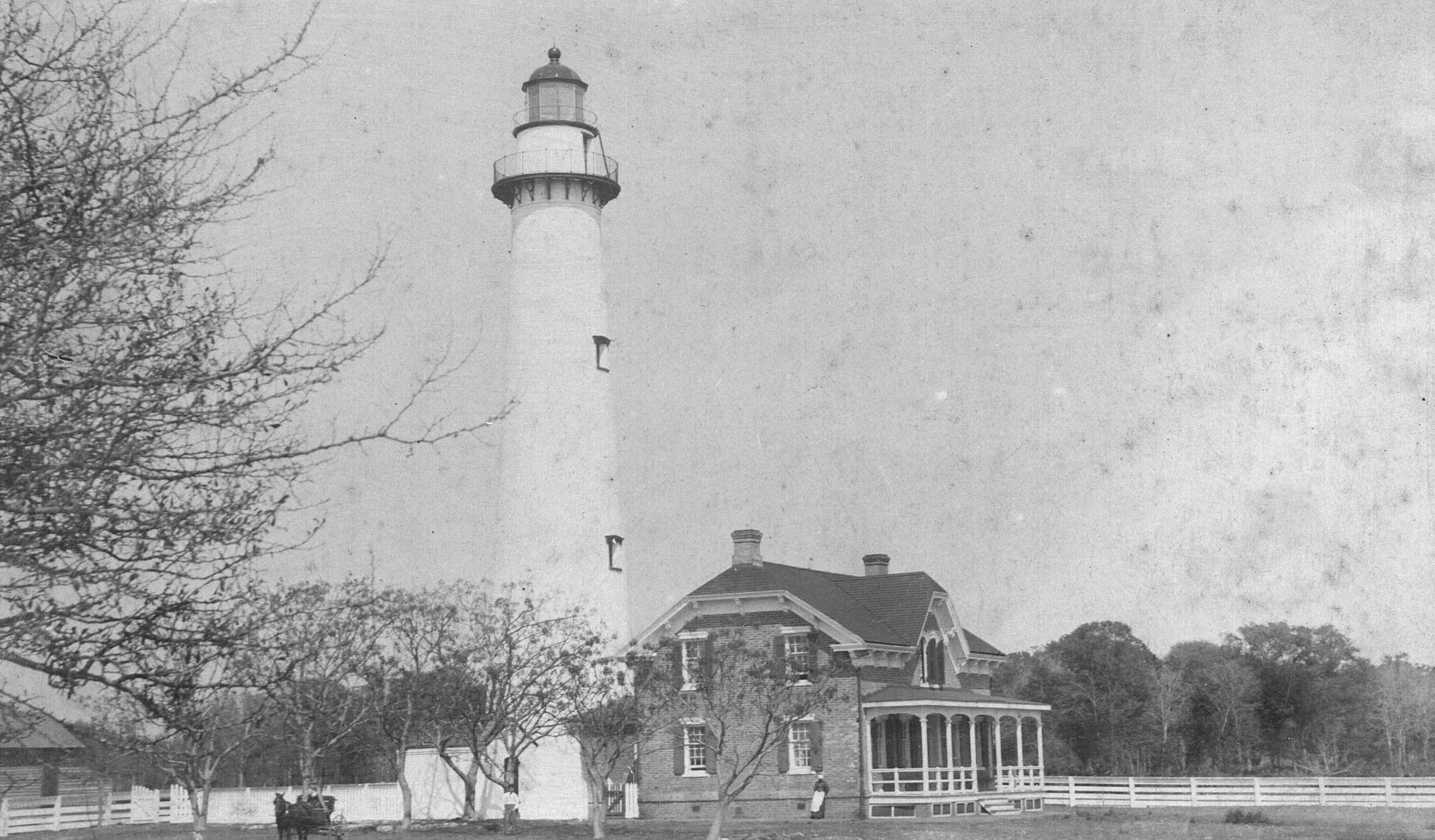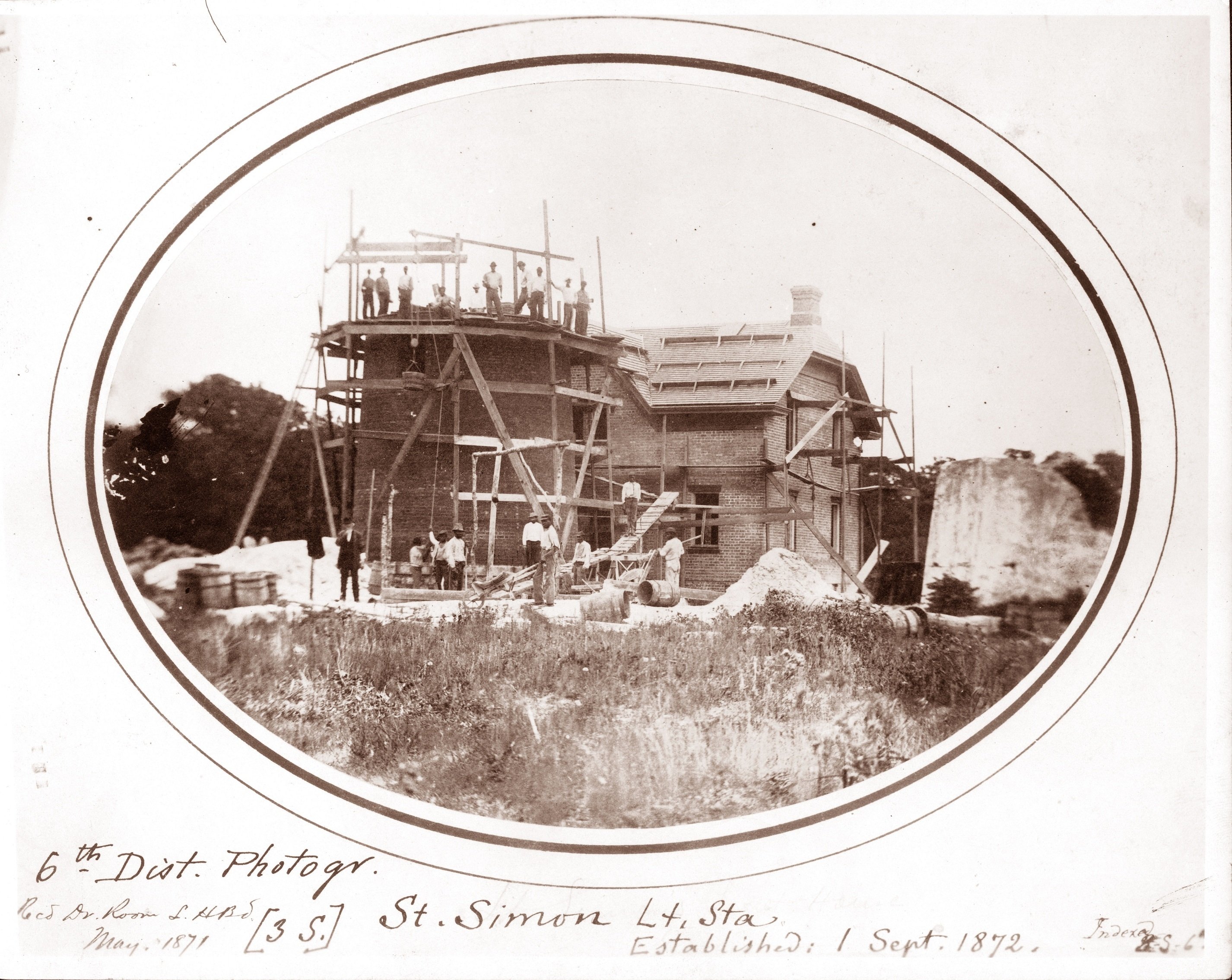
The St. Simons Lighthouse and Keeper’s Dwelling were built in 1868-1872, replacing an earlier light station destroyed during the American Civil War.
The tapering brick tower still serves as an Active Aid to Navigation and houses the original third order Fresnel lens. Designed and manufactured in France, the lens casts its beam 23 miles out to sea.
The Dwelling was home to lighthouse keepers and their families until the light was automated in the mid-1950s. In1975, the Dwelling became a museum of coastal history, operated by the Coastal Georgia Historical Society.
The First Lighthouse

In 1804, John Couper, owner of Cannon’s Point Plantation, deeded four acres of land at the southern end of St. Simons to the Federal government as the site for a lighthouse.
In May 1807, James Gould was awarded the contract to build the St. Simons Lighthouse for $13,775. The project included plans for a dwelling house, separate kitchen, oil house, and well. Born in Massachusetts in 1772, James Gould moved south in the 1790s to survey timber. In 1810, President James Madison appointed Gould to serve as the first keeper at an annual salary of $400. Gould acquired a cotton plantation on St. Simons and trained several of his slaves to maintain the Lighthouse.
Octagonal in shape, the Lighthouse had a base 25 feet in diameter, tapering to 10 feet in diameter at the top. The tower was 75 feet tall, with 8 foot thick walls at the foundation. The first light, an oil lantern probably fueled with whale oil, was suspended in an iron lantern room ten feet tall.
Gould’s lighthouse was constructed of tabby, except for the uppermost portion which was made of brick. Tabby, a building material often used along the southern coast, is a mixture of oyster shells, sand, water, and lime. The lime was made from burning oyster shells. Tabby salvaged from 18th century Fort Frederica may have been used in construction of the lighthouse.
At the beginning of the Civil War, a Confederate earthworks fort was built west of the Lighthouse. On September 29, 1861, the local Glynn Guards Infantry Company blew up the Lighthouse to keep it out of the hands of the Union Navy. The Fresnel lens, installed in 1857, was dismantled and removed “to the interior” prior to destruction of the tower. When Federal troops landed in Brunswick, they searched for the lens to no avail. It has never been found.
The Current St. Simons Lighthouse

The current Lighthouse and Keeper’s Dwelling were completed in 1872. Orlando Poe, chief engineer for the U.S. Lighthouse Board, supervised the design. Charles Cluskey, architect of many outstanding buildings in Georgia, served as contractor from 1868 until his death in 1871.
The Lighthouse is 104 feet tall and constructed of Savannah grey brick. It is 21 feet in diameter at the base, tapering to 10 foot in diameter at the base of the gallery. Its spiral cast iron staircase is encased within an 8 foot wide column, leaving space between the exterior and interior brick walls for the original rotational weight system of the lens. The decorative iron brackets supporting the Lighthouse gallery at the top echo the elements of Italianate architecture in the Keeper’s Dwelling design.
Since 1872, a 3rd order Fresnel lens, made in France, has projected the light that guides mariners into St. Simons Sound. The light was converted from kerosene oil lamp to electricity in 1934 and automated in the mid-1950s, ending the need for a resident keeper.
The light continues to be an Active Aid to Navigation maintained by the U.S. Coast Guard Auxiliary. The tower is painted solid white, known as its day mark. The original fixed light is surrounded by four rotating flash panels, resulting in a flash every sixty seconds — the night signature of the Lighthouse. By positioning the Lighthouse between two range towers to the west, mariners are safely guided into the St. Simons Channel and Sound.

In 1971, the Federal government conveyed ownership of the Dwelling to Glynn County for use as a museum. Coastal Georgia Historical Society restored the building in 1975 and since then has operated the Dwelling as a museum of coastal history. In 2004, the Society acquired the St. Simons Lighthouse under the National Historic Lighthouse Preservation Act.
The Keepers of the St. Simons Light

1810 James Gould
1837 Lachlan McIntosh
1852 Alexander D. McIntosh
1855 John F. Carmon
1872 Bradford B. Brunt
1874 Frederick Osborne
1880 George Asbell
1883 Isaac L. Peckham
1892 Joseph Champagne
1907 Carl Olaf Svendsen
1936 Arthur F. Hodge*
1945 David O’Hagan
*On July 1, 1939, the U.S. Lighthouse Service was abolished and merged into the U.S. Coast Guard. From the time, the official title of USLHS Keeper was changed to USCG Officer in Charge, usually at the rank of Chief Boatswain’s Mate.
The St. Simons Lighthouse turned 150 on September 1, 2022. To commemorate this special occasion, a light show was projected onto the tower.